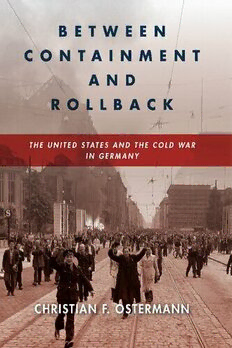
Between Containment And Rollback: The United States And The Cold War In Germany PDF
Preview Between Containment And Rollback: The United States And The Cold War In Germany
Between Containment and Rollback OOsstteerrmmaannnn..iinndddd ii 1111//1199//2200 11::1166 PPMM Published in collaboration with the Woodrow Wilson International Center for Scholars OOsstteerrmmaannnn..iinndddd iiii 1111//1199//2200 11::1166 PPMM BETWEEN CONTAINMENT AND ROLLBACK The United States and the Cold War in Germany Christian F. Ostermann Stanford University Press Stanford, California OOsstteerrmmaannnn..iinndddd iiiiii 1111//1199//2200 11::1166 PPMM Stanford University Press Stanford, California ©2021 by the Board of Trustees of the Leland Stanford Junior University. All rights reserved. No part of this book may be reproduced or transmitted in any form or by any means, electronic or mechanical, including photocopying and recording, or in any information storage or retrieval system without the prior written permis- sion of Stanford University Press. Printed in the United States of America on acid-free, archival-quality paper Library of Congress Cataloging-in-Publication Data Names: Ostermann, Christian F., author. Title: Between containment and rollback : the United States and the Cold War in Germany / Christian F. Ostermann. Description: Stanford, California : Stanford University Press, 2021 | Series: Cold war international history project | Includes bibliographical references and index. Identifi ers: LCCN 2019051240 (print) | LCCN 2019051241 (ebook) | ISBN 9781503606784 (cloth) | ISBN 9781503607637 (ebook) Subjects: LCSH: Cold War. | United States—Foreign relations—Germany (East) | Germany (East)—Foreign relations—United States. | United States—Foreign relations—1945-1953. | Germany—Foreign rela- tions—1945- | Germany (East)—History. Classifi cation: LCC E183.8.G3 O83 2019 (print) | LCC E183.8.G3 (ebook) | DDC 327.73043/109045—dc23 LC record available at https://lccn.loc.gov/2019051240 LC ebook record available at https://lccn.loc.gov/2019051241 Cover photo: June 17, 1953 Uprising—strikers on Leipziger Strasse on the way to Potsdamer Platz. Courtesy of Gert Schütz/Landesarchiv Berlin. Cover design: Rob Ehle Typeset by Kevin Barrett Kane in 10.2/14 Adobe Garamond Pro OOsstteerrmmaannnn..iinndddd iivv 1111//1199//2200 11::1166 PPMM To my parents, Elisabeth and Friedrich Ostermann OOsstteerrmmaannnn..iinndddd vv 1111//1199//2200 11::1166 PPMM This page intentionally left blank OOsstteerrmmaannnn..iinndddd vvii 1111//1199//2200 11::1166 PPMM Contents Preface: Writing East Germany into Cold War History ix Acknowledgments xvii Map of Allied Occupation Zones, 1945–1949 xxi 1 “Toward a Line down the Middle of Germany”: Containment at Potsdam, 1945 1 2 “Western Democracy on the Elbe”? Rollback through Cooperation 23 3 The United States and the Political Transformation of the Soviet Zone, 1946–1947 52 4 “Springboard for Penetration”: 1947–1949 79 5 “Preventing Roll-up”: Diplomatic Blockade, Free Elections, and the “Battle of Berlin” 105 6 Planning for Rollback in Germany, 1950–1951 135 7 The United States and the Cold Civil War in Germany: Eastern Initiatives and West German “Rollback” Efforts 158 8 Economic Cold War? The United States and Inter-German Trade, 1950–1952 196 9 “Roll Them Out for Keeps”: The United States and the 1953 East German Uprising 234 Conclusion 274 Notes 285 Index 373 OOsstteerrmmaannnn..iinndddd vviiii 1111//1199//2200 11::1166 PPMM This page intentionally left blank OOOOsssstttteeeerrrrmmmmaaaannnnnnnn....iiiinnnndddddddd vvvviiiiiiii 11111111////11119999////22220000 1111::::11116666 PPPPMMMM Preface Writing East Germany into Cold War History On February 9, 1990, U.S. president George H. W. Bush sat down to pen a per- sonal letter to West German federal chancellor Helmut Kohl. He wanted Kohl to know that he wholeheartedly supported the chancellor’s accelerated drive toward German unification. The situation in the German Democratic Republic (GDR) had been deteriorating. For many East Germans, change in the wake of the fall of the Berlin Wall on November 9, 1989, could not come fast enough. Thousands of East Germans went west, putting pressure on Kohl for fast-track unification. The West German leader was about to confront Soviet Communist Party secretary general Mikhail Gorbachev, who, by all accounts, held the key to Germany’s unity. Bush assured his German counterpart of “the complete readiness of the United States to see the fulfillment of the deepest national aspirations of the German people. If events are moving faster than expected, it just means that our common goal for all these years of German unity will be realized even sooner than we had hoped.”1 In characterizing his support of Kohl, Bush was on the mark. Sooner than other European leaders, the American president had developed a “comfort level” with the idea of German unification: “I’d love to see Germany reunited,” Bush told the Washington Times on May 16, 1989.2 It reflected his belief, as Robert Gates, the then–deputy national security adviser, later recalled, that “the Germans had changed, and he was prepared to gamble a great deal on that faith.”3 The president’s conviction that West Germany had become a stable democracy and a reliable ally positioned him and his administration to embrace the idea of a united Germany sooner than others, including the Germans themselves. His advisers, too, believed that “there OOsstteerrmmaannnn..iinndddd iixx 1111//1199//2200 11::1166 PPMM
